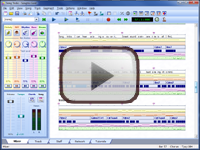(5.8) Time Signatures
Meter and time signatures refer to the same concept, but they are used slightly differently.
Meter is the property of music that it is based on an underlying, repeating beat rhythm, whereas time signatures are the symbols we use to identify and describe the meter in a piece of music.
There are many different time signatures used in music. So far we have encountered two of the most common, 4/4 and 3/4. In this topic, we will take a closer look at how they are constructed, and explore the range of time signatures you are most likely to see in music.
Time signatures consist of two numbers, resembling a fraction (which it is really, as we will see). Strictly speaking, the numbers should be placed one on top of the other, as they appear on staff lines. But when used in text, the closest approximation is to separate the numbers with a slash (as in 4/4).

The upper number is the count of beats in the meter. The lower number is the symbol length used to represent each beat. Together they tell us the total length of all symbols (notes and rests) in a bar.
The 4/4 time signature indicates a quadruple (four-beat) meter, where each beat is a quarter-note long. The total length of each bar will therefore be four quarter-notes, or 4/4 of a whole-note. This is the most widely used time signature and you will often see it notated simply as a 'C' for common time.

A 3/4 time signature indicates a triple (three-beat) meter, where each beat is a quarter-note long. The total length of each bar will therefore be three quarter-notes, or 3/4 of a whole-note. Are you starting to see how the time signature can be viewed as a fraction?
There are also duple (two-beat) meters. Compare the metronome beats of the three time signatures below.

There is sometimes flexibility in selecting a meter for a piece of music. For example, most music in 4/4 could also be written in 2/4 (and vice-versa) by substituting two bars of 2/4 for a single bar of 4/4. It really depends on how strong the emphasis seems to be on the third beat as to which you choose.

Meter can sometimes change within a piece of music. In this case, the new time signature must be shown at the start of each bar where a change occurs.


ChordWizard products such as Songtrix offer unlimited flexibility with time signature changes. Any or every bar can have a new time signature. The notation in Staff View is updated automatically.
Four is not the only number which can appear on the bottom of a time signature. Instead of quarter-notes, time signatures can also use beats of eighth-notes (quite common) and half-notes (quite rare).
Compare the difference in speed. Half-note meters are half as fast and eighth-note meters are twice as fast as quarter-note meters.


Other beat lengths, such as whole-notes, sixteenth-notes, thirty-second-notes, and so on, are also theoretically possible, but are not particularly useful and are generally unheard of.
All of the time signatures that we have seen so far are known as simple meter, based on duple, triple or quadruple beats.
Time signatures with larger beat numbers are possible, and these are known as composite meter as the larger beat count is usually broken down into a combination of duples, triples or quadruples.
A composite time signature itself does not specifically indicate how the beat count should be split, but there are conventions for how various meters are usually constructed.
For example, 5/4 meter most often has a 'one - two - three - one - two' feel, in effect acting as alternating bars of 3/4 + 2/4. You should be able to hear this effect in the sample below, both with and without the metronome.

This does not have to be the case though, as depending on the music, 5/4 meter could also have a 2/4 + 3/4 tendency. For higher beat counts, various breakdowns are possible. Consider these examples, where the metronome uses a sub-accent to show where the breaks are made.



There is a special class of composite meter where the number of beats is a multiple of three (6, 9, 12, etc). This is called compound meter and it has a very strong triplet feel, since the beats are almost always split into subsets of three.
A few common examples are shown below. Although the large number of beat counts in each bar may look strange, these meters turn out to be very useful, as we will see shortly.


ChordWizard products such as Songtrix offer a wide range of half-note, quarter-note, and eighth-note time signatures for you to use in your songs, including all common meters in all musical styles.
|
Topic 67 of 117
| ||
Bring these music concepts to life with the free Songtrix Bronze Edition as you create songs from chords and scales.
Then publish and share your ideas with the other musicians you meet on the ChordWizard Network.
Have questions? Join the ChordWizard Network and post them in the Music Theory forum for answers and discussions on your topics of interest.








